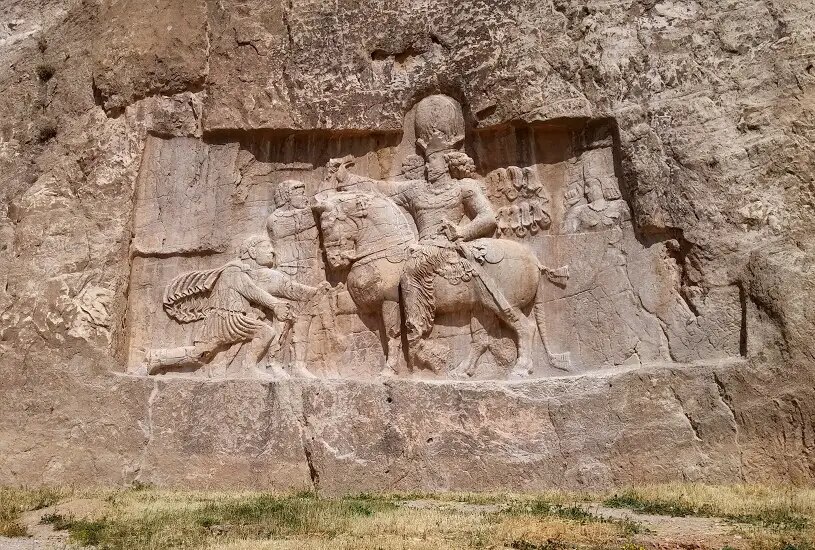Tang-e Chogan: a peek into enigmatic legacy of Sassanids

TEHRAN – Deep within the heart of Iran lies the awe-inspiring site of Tang-e Chogan, a captivating testament to the grandeur of the Sassanid Empire (224–651).
Visiting Tang-e Chogan (literary meaning “Chogan gorge”) is an immersive experience, allowing travelers to traverse the corridors of time and witness the grandeur of an ancient empire. The journey to this historical site involves navigating through awe-inspiring landscapes, adding to the allure of the excursion.
The site is located near Bishapur (“Shapur’s City”) of Fars province. As visitors explore the ruins, guided tours, and informational placards offer invaluable context, unraveling the mysteries of the Sassanid era. Additionally, the serene surroundings and picturesque vistas create an ambiance that transports visitors to a bygone era, making Tang-e Chogan an unforgettable destination for history enthusiasts and culture aficionados alike.
Tang-e Chogan is home to six reliefs related to Shapur I and Bahram I and II. There is also a large statue of Shapur I, which is six meters high, located in the Shapur Cave, at a height of about 700 meters from the river bed.
Furthermore, the site embraces larger and more crowded reliefs than any other Sassanid era reliefs, with three of them being more than 30 square meters in size and a body of more than 30 persons in each relief.
The first relief, which is larger and more crowded than any other one, is a scene celebrating Shapur I’s victory over the Roman Empire. Shapur I can be seen in the center of the relief riding on a horse and Gordianus’s corpse is under the feet of Shapur’s horse, Valerian’s hands are held captive in Shapur’s hand and Philip kneels in front of Shapoor’s horse and demands peace. The Persian military and officers are also behind Shapur in five rows of horses and the Roman officers and noblemen are seen in 5 rows carrying gifts and offerings in front of King Shapur I.
The second one represents the victory of King Bahram II over the Arabs. On the left is Bahram on horseback, and the Arabs are led by Iranian commanders to offer the king horses and camels.
The third bas-relief shows the ceremony of the Bahram I receiving a royal ring from Ahura Mazda. The engraving of this amazing relief is very artistic and even the wrinkles and the details of the clothes and so on are all beautifully illustrated. Everything in this relief fits in amazingly well. Even the physical details of the horse and the veins on the horse’s legs have been shown.
The fourth one depicts the scene of the victory of Bahram II over the rebels, in which the king sits on the throne in the center, while on his right side stand the Iranian commanders and soldiers with respect, and the rebels and captivates on the left. They are brought by Iranian soldiers to the presence of the king.
The fifth bas-relief located on the right side of the gorge is the most intact and complete relief among the others. It is about Shapur’s victory over the Roman Empire.
The sixth one depicts the ceremony of Shapur I receiving a royal ring from Ahura Mazda, as well as his victory in the war against the Romans. In this relief, both King and Ahura Mazda (the creator and highest deity of Zoroastrianism) are shown riding on horses and facing each other.
The Sassanid era is of very high importance in the history of Iran. Under the Sassanids, Persian art and architecture experienced a general renaissance. Architecture often took grandiose proportions, such as the palaces at Ctesiphon, Firuzabad, and Sarvestan, which are amongst the highlights of the ensemble.
Crafts such as metalwork and gem engraving grew highly sophisticated, yet scholarship was encouraged by the state. In those years, works from both the East and West were translated into Pahlavi, the language of the Sassanians.
Rock-carved sculptures and bas-reliefs on abrupt limestone cliffs are widely deemed as characteristics and striking relics of Sassanian art, top examples of which can be traced at Bishapur, Naqsh-e Rostam and Naqsh-e Rajab in southern Iran.
In 2018, UNESCO added an ensemble of Sassanian historical cities in southern Iran — titled “Sassanid Archaeological Landscape of Fars Region”-- to its World Heritage list. The ensemble comprises eight archaeological sites situated in three geographical parts of Firuzabad, Bishapur, and Sarvestan. It reflects the optimized utilization of natural topography and bears witness to the influence of Achaemenid and Parthian cultural traditions and Roman art, which later had a significant impact on the architecture and artistic styles of the Islamic era.
The Sassanid archaeological landscape also represents a highly efficient system of land use and strategic utilization of natural topography.
AFM
Leave a Comment